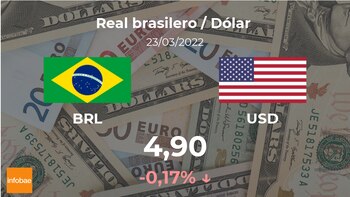
The US dollar is trading at the opening at 4.90 Brazilian reals on average, which implied a decrease of 0.17% compared to the previous day's value of 4.91 Brazilian reals on average.
Taking into account the last seven days, the US dollar has fallen by 3.46%, so in year-on-year terms it still maintains a decrease of 12.73%. In relation to past days, it accumulates six successive sessions of negative numbers. As for the volatility of recent dates, it is manifestly lower than that accumulated in the last year, which shows that we can say that it is going through a period of greater stability lately.
In the annual photo, the US dollar has even changed by a high of 5.71 Brazilian reals on average, while its lowest level has been 4.90 Brazilian reals on average.
The Brazilian currency
El real, or the Brazilian real as it is known internationally, is the legal tender in Brazil and is the twentieth most circulated currency in the world and the second in Latin America only behind the Mexican peso.
Inforce since 1994, the real replaced the “cruzeiro real” and its abbreviation is BRL; it is also the fourth most traded currency in the American continent only behind the US dollar, Canadian dollar and Mexican peso.
One of the episodes that most marked the Brazilian currency was when in 1998 the real suffered a strong speculative attack that caused its devaluation the following year, going from a value of 1.21 to 2 reais per dollar.
There are currently 1 and 5 cent copper coins, 10 and 25 cents bronze coins and 50 cents cupronickel coins. The coin of a real is bimetallic. It should be noted that in 2005 the pennies were discontinued, but it is still legal tender.
On the economic front, the International Monetary Fund (IMF) cut Brazil's growth by 1.7 percentage points for 2022, especially due to the deterioration of global conditions between high inflation and the COVID-19 pandemic.
It should be noted that the Brazilian economy, the largest in the Latin American region, entered a recession in the second quarter of 2021 and is forecast to stagnate throughout 2022.
Due to COVID-19, Brazil was forced to disburse more money as stimulus measures (about 12% of GDP) in order to cope with the pandemic, which ultimately resulted in a budget deficit for 2022.
Agencies
Últimas Noticias
Debanhi Escobar: they secured the motel where she was found lifeless in a cistern
Members of the Specialized Prosecutor's Office in Nuevo León secured the Nueva Castilla Motel as part of the investigations into the case

The oldest person in the world died at the age of 119
Kane Tanaka lived in Japan. She was born six months earlier than George Orwell, the same year that the Wright brothers first flew, and Marie Curie became the first woman to win a Nobel Prize

Macabre find in CDMX: they left a body bagged and tied in a taxi
The body was left in the back seats of the car. It was covered with black bags and tied with industrial tape
The eagles of America will face Manchester City in a duel of legends. Here are the details
The top Mexican football champion will play a match with Pep Guardiola's squad in the Lone Star Cup

Why is it good to bring dogs out to know the world when they are puppies
A so-called protection against the spread of diseases threatens the integral development of dogs




